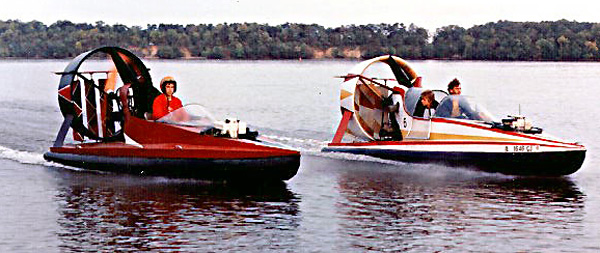|
 Grab
the fully articulated, aircraft-style joystick, twist the throttle grip and blast off.
Suddenly you're flying at more than 75 mph over land or water, soaring over 8-inch
obstacles, even climbing 45-degree hills. You're riding Tri-Flyer, a high-tech,
super-performing hovercraft that you can build from plans. Grab
the fully articulated, aircraft-style joystick, twist the throttle grip and blast off.
Suddenly you're flying at more than 75 mph over land or water, soaring over 8-inch
obstacles, even climbing 45-degree hills. You're riding Tri-Flyer, a high-tech,
super-performing hovercraft that you can build from plans.
It's built of wood station
formers and stringers, which are covered with an 1/8-inch plywood skin; much like the
construction of a wooden boat. Lift comes from a 10-hp vertical-shaft mower engine driving
a 26-inch, 4-bladed fan that forces air underneath the hull. The Tri-Flyer will lift three
occupants - a total payload of 800 pounds. A separate snowmobile type engine (40-hp to
80-hp) powers a ducted prop in the rear, which delivers up to 400 pounds of thrust. With
an 80-hp engine, you can climb a 45 degree grade (single occupant).
Tri-Flyer's highly efficient power system comes from carefully optimizing the
relationship between weight, thrust, and drag. Three rudders and a horizontal
pitch-control wing mounted on the duct provide the control. The three rudders give
directional control, and the horizontal pitch airfoil supplies the correct fore-and-aft
trim. When trimmed in the pitch direction, Tri-Flyer achieves maximum speed. All controls, including throttles, are routed to the 3-axis control stick.
Tri-Flyer can fly over land, water, ice and snow. She can land on ice that is too thin
to walk on, and in water where she'll float, just like an ordinary boat.
Expect to spend 150 to 300 hours building Tri-Flyer, and about $700 in materials, not
counting the engines and fans. The cost of engines will depend on whether you
purchase them new or used. Plans give the source for purchasing the fans. Required
building skills are minimal. Tri-Flyer is built much like a wooden boat.
 Tri-Flyer was featured in Popular Mechanics magazine. Click on the small
images in the left margin to see larger images. Tri-Flyer was featured in Popular Mechanics magazine. Click on the small
images in the left margin to see larger images.
Specifications |
General
Length: 190 inch
Width: 78 inch
Height (on cushion): 72 inch
Empty Weight: 450 lbs
Flotation: 1500 lbs
Construction: Wood monocoque
Construction Time: 150-300 hours
Seating: Three (central pilot, two behind the pilot)
Lift System
Engine: Briggs & Stratton or Tecumseh
Power: 8 hp to 10 hp
Type: Four-cycle, vertical shaft,
aluminum case
Weight: 40-50 lbs
Drive: Direct
Fan: 26 inch diameter, 4 blade, 18-20 pitch
Control System
Yaw Control: Multiple rudders in propwash
Pitch Trim: Horizontal airfoil in propwash
Type: Fully-articulated joystick |
Thrust System
Engine: As desired
Power: 40-80 hp
Type: Two-cycle, aluminum case
Weight: Up to 100 lbs
Drive: Multiple vee-belt, 2.64:1 ratio
Propeller: 54 inch diameter, 2 blade,
36 pitch
Performance
Payload: Up to 800 lbs
Hover Height: 8 inch (obstacle
clearance)
Thrust: 125 to 400 lbs*
Climb Grab: 15 to 45 degrees*
Speed: 40-70 mph over water,*
40-80 mph over land, ice, and snow*
*Depends on the power of the thrust engine |
|
![]()






